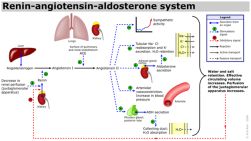 Our bodies are amazing self-monitoring and self-maintaining systems – and we take them completely for granted!
Our bodies are amazing self-monitoring and self-maintaining systems – and we take them completely for granted!
The fact that it is all automatic is good news for us because it frees us up to concentrate on other things – BUT – it has a sinister side too. Our automatic monitor-and-maintain design does not imply what is maintained is healthy – the system is just designed to keep itself stable.
Take our blood pressure as an example. We all have two monitor-and-maintain systems that work together – one that stablises short-term changes in blood pressure (such as when you recline, stand, run, fight, and flee) and the other that stablises long-term changes. The image above is a very simplified version of the long-term regulation system!
Around one quarter of all adults are classified as having high blood pressure – which means that it is consistently higher than is healthy – and billions of £ are spent every year on drugs to reduce blood pressure in millions of people. Why is this an issue? How does it happen? What lessons are there for the student of Improvement Science?
High blood pressure (or hypertension) is dangerous – and the higher it is the more dangerous it is. It is called the silent killer and the reason is that it is called silent is because there are no symptoms. The reason it called a killer is because over time it causes irreversible damage to vital organs – the heart, kidneys and arteries in the brain.
The vast majority of hypertensives have what is called essential hypertension – which means that there is no obvious single cause. It is believed that this is the result of their system gradually becoming reset so that it actively maintains the high blood pressure. This is just like gradually increasing the setting on the thermostat in our house – say by just 0.01 degree per week – not much and not even measurable – but over time the cumulative effect would have a big impact on our heating bills!
So, what resets our long-term blood pressure regulation system? It is believed that the main culprit is stress because when we feel stressed our bodies react in the short-term by pushing our blood pressure up – it is called the fright-fight-flight response. If the stress is repeated time and time again our pressure-o-stat becomes gradually reset and the high blood pressure is then maintained, even when we do not feel stressed. And we do not notice – until something catastrophic happens! And that is too late.
The same effect happens in organisations except that the pressure is emotional and is created by the stress of continually fighting to meet performance targets. The result is a gradual resetting of our expectations and behaviours and the organisation develops emotional hypertension which leads to irreversible damage to the organisations culture. This emotional creep goes largely unnoticed until a catastrophic event happens – and if severe enough the organisation will be crippled and may not survive. The Mid Staffs Hospital patient safety catastrophe is a real and recent example of cultural creep in a healthcare organisation driven by incessant target-driven behaviour. It is a stark lesson to us all.
So what is the solution?
The first step is to realise that we cannot just rely on hope, ignore the risk and wait for the early warning symptoms – by that time the damage may be irreversible; or the catastrophe may get us without warning. We have to actively look for the signs of the creeping cultural change – and we have to do that over a long period of time because it is gradual. So, if we have just be jolted out of denial by a too-close-for-comfort expereince then we need to adopt a different strategy and use an external absolute reference – an emotionally and culturally healthy organisation.
The second step is to adopt a method that will tell us reliably if there is a significant shift in our emotional pressure and a method that is sensitive eneough to alert us before it goes outside a safe range – because we want to intervene as early as possible and only when necessary. Masterly inactivity and cat-like observation according to one wise medical mentor.
The third step is to actively remove as many of the stressors as possible – and for an organisation this means replacing DRATs (Delusional Ratios and Arbitrary Targets) with well-designed specification limits; and replacing reactive fire-fighting with proactive feedback. This is the role of the leaders.
The fourth step is to actively reduce the emotional pressure but to do it gradually because the whole system needs to adjust. Dropping the emotional pressure too quickly is as dangerous as discounting its importance.
The key to all of this is the appropriate use of data and time-series analysis because the smaller long-term shifts are hidden in the large short-term variation. This is where many get stuck because they are not aware that there two different sorts of statistics. The correct sort for monitoring systems is called time-series statistics and it not the same as the statistics that we learn at school and university. That is called comparative statistics. This is a shame really because time-series statistics is much more applicable to every day life problems such as managing our blood pressure, our weight, our finances, and the cultural health of our organisations.
Fortunately time-series statistics is easier to learn and use than school statistics so to get started on resetting your personal and organisational emot-o-stat please help yourself to the complimentary guide by clicking here.
